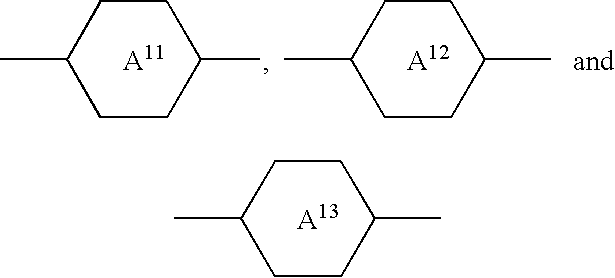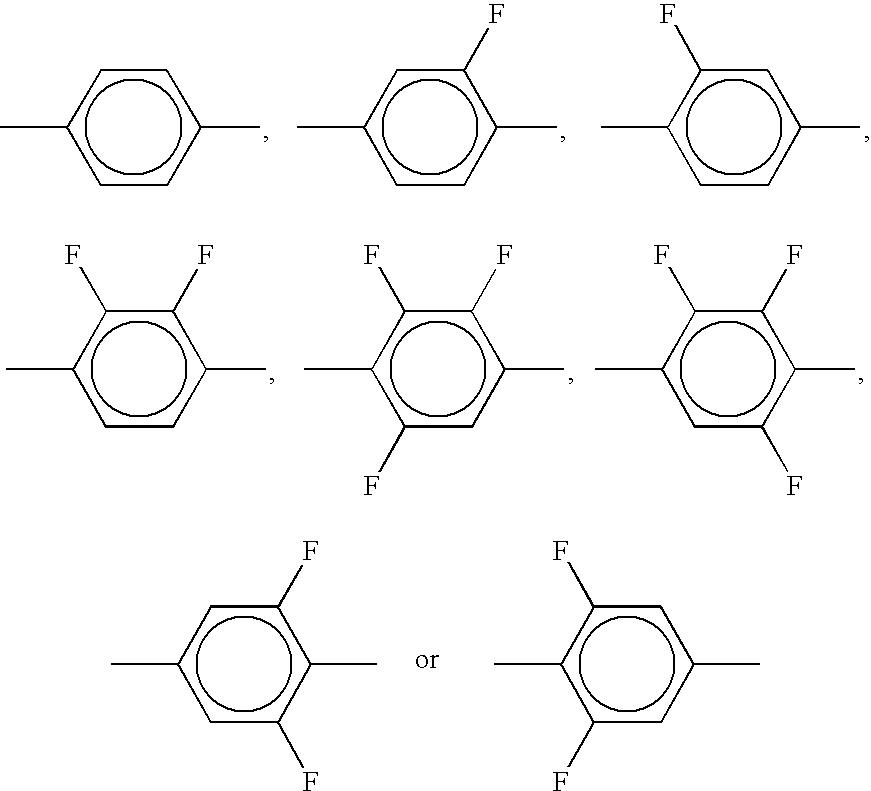Electro-optic light control element, display and medium
a technology of optical effects and liquid crystal displays, applied in the field of optical effects employed in liquid crystal displays
- Summary
- Abstract
- Description
- Claims
- Application Information
AI Technical Summary
Benefits of technology
Problems solved by technology
Method used
Image
Examples
example 1
[0134] A liquid-crystal mixture of the following composition was prepared.
5 Compound / abbreviation Concentration / % by weight ME2N.F 3.0 ME3N.F 3.0 ME4N.F 8.0 ME5N.F 8.0 UM-3-N 4.0 PTG-3-N 8.0 PTG-5-N 8.0 PTU-4O-N 8.0 PU-3-AN 8.0 PU-5-AN 8.0 PGU-2-F 10.0 PGU-3-F 10.0 PGU-5-F 10.0 HP-3N.F 4.0 .SIGMA. 100.0
[0135] This mixture had the following properties:
6 Clearing point (T(N, I)) / .degree. C.: 23.8 n.sub.e (20.degree. C., 589.3 nm): 1.6971 .DELTA.n (20.degree. C., 589.3 nm): 0.1456 .epsilon..parallel. (20.degree. C., 1 kHz): 47.4 .DELTA..epsilon. (20.degree. C., 1 kHz): 27.3
[0136] An electro-optical test cell containing a light modulation element containing the liquid-crystal mixture was produced. The substrates consisted of glass. Substrates without an alignment layer were used. The electrode structure consisted of electrodes intermeshing in a comb-like manner. The width of the electrodes was 20 .mu.m and the separation of the electrodes from one another was 10 .mu.m. The layer thickne...
example 2
[0138] A liquid-crystal mixture of the following composition was prepared.
7 Compound / abbreviation Concentration / % by weight UM-3-N 10.0 PYP-3N.F.F 15.0 HP-3N.F 10.0 CUZU-2-N 10.0 CUZU-3-N 10.0 UVZG-3-N 10.0 GZU-4O-N 10.0 GZU-4-N 1.0 GZU-3A-N 12.0 UZU-3A-N 12.0 .SIGMA. 100.0
[0139] This mixture had the following properties.
8 Clearing point (T(N, I)) / .degree. C.: 24.8 n.sub.e (21.degree. C., 589.3 nm): 1.6372 .DELTA.n (21.degree. C., 589.3 nm): 0.1122
[0140] As in Example 1, an electro-optical display was produced and its characteristic line measured. The temperature was 26.5.degree. C. The characteristic line is shown in FIG. 1. The characteristic line starts at low voltage with a relative intensity of 0% and rises with increasing voltage. The value for the threshold voltage (V.sub.10) was 34 V, the value for the mid-grey voltage (V.sub.50) was 53 V and the value for the saturation voltage (V.sub.90) was 64 V. At a voltage of 69 V, the maximum intensity is reached. Thereafter, the rela...
example 3
[0142] A liquid-crystal mixture of the following composition was prepared.
9 Compound / abbreviation Concentration / % by weight UM-3-N 10.0 GZU-3A-N 10.0 UVZG-3-N 10.0 PWZU-3-N 7.0 PU-3-AN 16.0 PU-5-AN 16.0 PTG-3-N 15.0 PTU-4O-N 15.0 HP-3N.F 1.0 .SIGMA. 100.0
[0143] This mixture had the following properties.
10 Clearing point (T(N, I)) / .degree. C.: 22.9 n.sub.e (19.degree. C., 589.3 nm): 1.7298 .DELTA.n (19.degree. C., 589.3 nm): 0.1765
[0144] As in Example 1, an electro-optical display was produced and its characteristic line measured. The temperature was 23.1.degree. C. Compared with the results from Example 2, the characteristic line in this example is shifted towards significantly lower voltages. The value for the threshold voltage (V.sub.10) was 36.5 V, the value for the mid-grey voltage (V.sub.50) was 55 V and the value for the saturation voltage (V.sub.90) was 61.5 V. The maximum was at 65 V and the minimum at 83 V and at a relative intensity of about 32%. At a voltage of 126 V, the...
PUM
 Login to View More
Login to View More Abstract
Description
Claims
Application Information
 Login to View More
Login to View More - R&D
- Intellectual Property
- Life Sciences
- Materials
- Tech Scout
- Unparalleled Data Quality
- Higher Quality Content
- 60% Fewer Hallucinations
Browse by: Latest US Patents, China's latest patents, Technical Efficacy Thesaurus, Application Domain, Technology Topic, Popular Technical Reports.
© 2025 PatSnap. All rights reserved.Legal|Privacy policy|Modern Slavery Act Transparency Statement|Sitemap|About US| Contact US: help@patsnap.com



